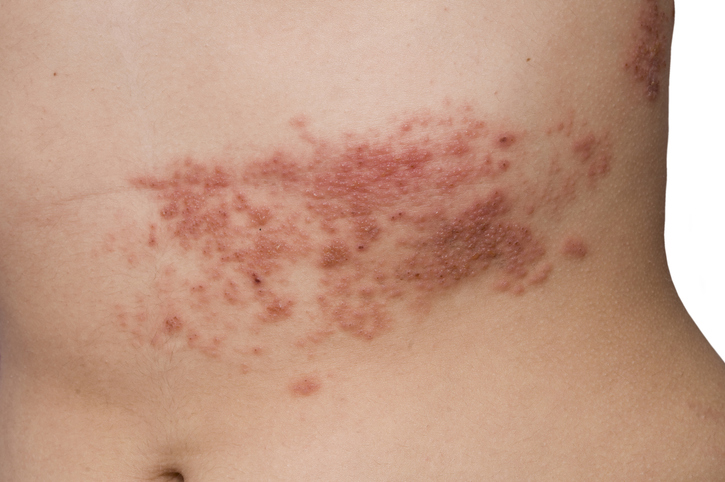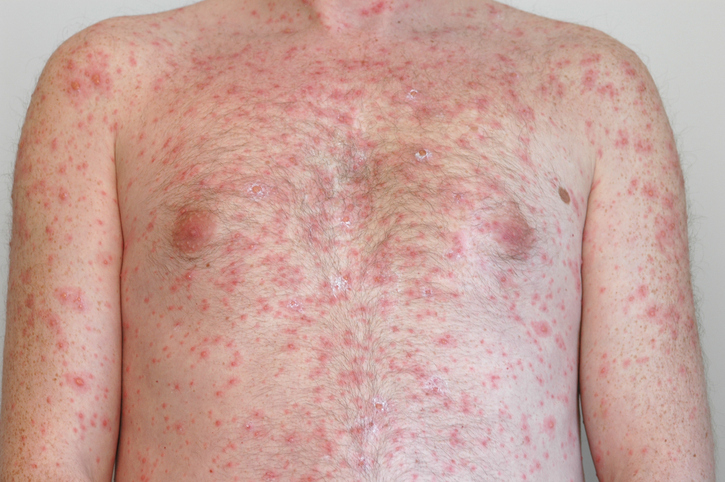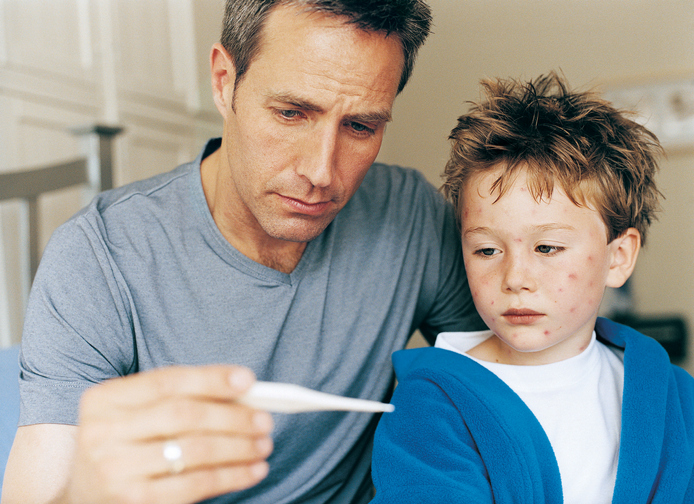Chickenpox: How does it manifest, what does it look like? Adults with complications

Chickenpox, or varicella, is a highly infectious disease that occurs mostly in childhood, but it is still mostly mild. However, an outbreak in newborns or adults is a risk.
Most common symptoms
- Malaise
- Abdominal Pain
- Headache
- Sore Throat
- Skin pain
- Nerve pain
- Fever
- Increased body temperature
- Nausea
- Hyperpigmentation
- Scars
- Rash
- Indigestion
- Blisters
- Buds
- Dry cough
- Muscle weakness
- Itchy skin
- Fatigue
- Reddened skin
- Winterreise
- Enlarged lymph nodes
Characteristics
Chickenpox, also known as varicella, is a highly contagious disease.
There is almost no-one who has not heard about smallpox and what its symptoms are. The rash begins as small red dots on the child's skin and the baby is red that later turn into white cream-like liquid-filled dots.
But, what do they look like, and is it possible to distinguish them from measles, for example?
In addition, the symptoms are not just on the skin.You've probably heard that they can cause complications, especially in adulthood.For adults, it is not just one rash that will deprive them of their strength and cause fatigue.
FAQ: What is chickenpox? How to get rid of them as soon as possible?
Varicella = chickenpox.
Variola = smallpox.
Let's start with chickenpox from the beginning...
The causative agent is varicella-zoster virus, or VZV (human alphaherpesvirus 3, or HHV-3).
More specifically, it is a DNA virus of the family Herpesviridae, subfamily Alphaherpesvirinae (α-herpesvirus).
The virus is spread worldwide and most people will overcome smallpox in childhood. In about 2% of the population, it appears after the age of 20. It is reported that more than 95% of the adult population is already immune to chickenpox.
Chickenpox appears during primary infection with the varicella virus.
The virus is spread by droplet infection through the air or often through direct contact. It penetrates the body through the respiratory tract or the conjunctiva.
Following penetration into the human body, it multiplies in the mucous membranes of the airways. At this time, asymptomatic viremia usually occurs, i.e. there are no noticeable symptoms or issues. The virus spreads throughout the body through lymphatic tissue and blood, and may further multiply in some organs.
Approximately 15 days after infection, the second wave of viremia occurs, so-called secondary viremia. At this time, the virus enters the bloodstream and skin to a large extent.
Typical skin changes occur.
After a while, the body and the immune system cope with the difficulties and the disease subsides. However, the virus is not destroyed.
VZV survives and remains dormant, i.e. existing in a latent form, in the ganglia of the sensitive nerves of the brain and spinal cord. If there are favourable conditions for the virus, it will manifest as a secondary infection in the form of shingles.
A reactivation of VZV causes a disease known as herpes zoster.
FAQ: chickenpox
Varicella, or chickenpox, is a highly contagious disease about which we know certain things that we can use to answer some commonly asked questions.
At what age does it occur?
Chickenpox is a typical childhood disease, but it can affect people of any age.
The main category is children of preschool and school age, i.e. children around the age of 10. At this age, the course of the disease is mild.
Does this disease have a seasonal occurrence?
Yes. It is reported that the main season for the disease is the winter and spring.
What is the incubation period of the disease?
The incubation period ranges from 10 to 25 days. However, the average is around 14 days. In some cases, it lasts up to 3 weeks, especially in people with immune disorders.
When is the disease transmitted, i.e. infectious?
The highest rate of infectivity begins 2 days before the first occurrence of skin rashes.
It ends approximately 7 days after the first sowing, when the last rash dries out and crusts over.
Does long-term immunity develop after recovery?
This is a common belief. However, it is not about immunity as such. The virus survives as a dormant virus in the body and may reactivate under suitable conditions and manifest itself as shingles.
Can the disease occur more than once in one person?
Yes.
In most cases, chickenpox occurs only once in a lifetime. However, there are known cases of recurrence, but it is very rare.
Is there a chickenpox vaccination?
Yes.
Causes
The cause of the disease is the varicella zoster virus which spreads through the air - airborne transmission or droplet infection.
The source of the infection is an infected person.
The virus is released from the mucous membranes of the respiratory tract, but also from skin rashes before drying out and crusting over. This happens before the end of the incubation period, approximately 2 days before the rash appears.
The rash disappears after all skin lesions have dried out and crusted. This usually comes 7 days after the first rash. It is reported to occur about 3 days after the last rash.
In some cases, the duration of infection is longer, for example if the infected person has weakened immunity.
The virus penetrates the body through the mucous membranes of the upper respiratory tract, oral and nasal cavities (nasopharynx) and lymphatic tissue, where it multiplies. Subsequently, it spreads through the lymph and blood to the reticuloendothelial system.
The virus is also transmitted transplacentally - that is, through the placenta from the pregnant woman to the fetus.
The virus spreads to skin cells in a secondary viremia, resulting in a typical rash.
After overcoming the difficulties of the immune system, the herpesvirus is stored in the nerve sensory ganglia. It is not completely eliminated and removed from the body. When the virus is reactivated, it appears as shingles.

Symptoms
The course of chickenpox is usually mild, which is typically the case for the preschool and school age.

Chickepox occurs in neonates, adolescents and adults. The risk is the development of various complications.
It is an acute illness, it is sudden. Prodromal symptoms may appear initially, especially in older children and adults. They appear in the form of a fever, such as the flu.
During secondary viremia, i.e. when the virus spreads through the blood to the body and skin, a typical skin rash develops.
Table: individual stages of smallpox
| Stadium | Symptoms |
| Prodromal |
|
| Rash stage |
after incubation period - approximately 14 days
|
In some cases, chickenpox has a complicated course
As mentioned, it takes a mild form for preschool and school children. In the prodromal stage, the child may not experience any or only mild difficulties.
The situation changes only...
...if the primary infection and the disease occur in older children, adolescents or adults. A separate group are newborns, where several variants are distinguished according to the time of infection.
98% of chickenpox cases occur in children under 10 years of age, about 2% over the age of 20.
In this case, prodromal disorders are more common. Consequently, the number of skin defects tends to be more numerous.

Similarly, it can be worse in children with skin problems such as eczema or after a recent skin burn due to excessive sun exposure.
Hypopigmentation (lighter patches of skin) or hyperpigmentation lasts for a longer period of time, even up to weeks. Alternatively, generalised lymphadenopathy - enlargement of the lymph nodes - may occur.
Question:Do these skin defects leave any scars?Yes (in some cases).
However, this is not usual. However, scratching blisters will leave scars later on. The risk of scarring is mainly secondary infection of skin defects by bacteria.
It is most often a staphylococcal infection.
Sepsis rarely occurs. Sepsis, septicemia, or a septic shock is the result of the spread of pathogens through the body through the blood.
Read also: Shock.
There may be bleeding in cases of thrombocytopenia or disseminated intravascular coagulation.
Other complications due to chickenpox:
- encephalitis - inflammation of the brain
- neurological disorders, myelitis, polyneuritis
- damage to other organs
- lungs - pneumonia
- heart - myocarditis, pericarditis
- liver - hepatitis
- kidney - glomerulonephritis
- orchitis - inflammation of the testes
- arthritis - joint inflammation
- and other conditions
Risk groups...
A higher risk of complications must be taken into account, especially in adulthood. But also in people with weakened immunity, after organ transplantation, HIV - AIDS, oncological diseases or malnutrition.
Progressive varicella syndrome - a name for a severe form of the disease.
Pregnancy, fetus and newborns
If the disease occurs in a pregnant woman in the first trimester (the first three months of pregnancy), smallpox can be the cause of birth defects. Examples are eye and brain defects, affected peripheral nervous system, skull, limbs or the presence of scars on the skin of the fetus.
The condition is called congenital, or congenital varicella syndrome.
This is a rare condition. According to statistics, there is a 2% chance of this happening in mothers with varicella during this period.
The virus also crosses the placenta in the last 2-3 weeks.
Also, there is a risk of disease at birth or shortly after birth. It is called neonatal varicella, which is chickenpox in newborns.
In this case, the course of the disease may be milder in casethe fetus or the baby have some antibodies that have crossed the placenta from the mother.
In other cases...
Severe course, high mortality and organ damage have been reported in cases of chickenpox in mothers during the last 5 days of pregnancy and 2 days after birth.
The reason is the lack of antibodies that did not cross the placenta into the fetus.
Varicella-zoster immune globulin and antiviral (acyclovir) will be administered.
Diagnostics
No special examination methods are needed to diagnose chickenpox.
Medical history and clinical picture are sufficient, as the disease has a typical course presenting with skin rash.
In case of doubt, blood sampling and VZV - IgM serological testing as well as enzyme-linked immunosorbent assay (ELISA), radioimmunoassay (RIA), complement fixation test, Ppolymerase chain reaction (PCR), or virus culture will be performed. The presence of viruses in the fluid within blisters also serves as direct evidence that we can check with an electron microscope and a Tzank test, or the chickenpox skin test, which is performed with a microscopic examination of traces of blisters.
It is important to distinguish chickenpox from other diseases - differential diagnosis.
Measles is a much more serious disease. Other examples are generalized herpes zoster, rickettsialpox, enterovirus, streptococcal impetigo, allergic rash or skin damage by insects or small rodents.
Table: main differences between measles and chickenpox
| Symptom | Measles | Chickenpox |
| Body temperature | Increase in body temperature to fever 38 °C - 40 °C The second sharp rise in temperature when sowing rashes | Temperature elevation during a wave of rashes |
| Conjunctival congestion | Typical symptom | No |
| Spots in the mouth | Yes - typical Gray on a reddish background | No |
| Rash | Initially behind the ears and on the nape | Blister-like rashes on the body appearing in waves |
| Stuffy nose | Yes | No |
| Cough | Dry and barking cough | No |
Read also:
Course
The course of the disease is mild inchildren under 10 years of age.
In older children, adolescents and adults, and in other specific cases, the course is more complicated. You will find more details in the section on the symptoms.
After an incubation period of usually 14 days, the prodromal stage begins 2 days before the rash is sown. The course of the disease may be without symptoms and show no signs of temperature.

Then the skin rash appears. It comes in several waves, so it is possible to observe all stages of the rash on the body, from dots to skin defects with scabs.
The spots are accompanied by an increase in body temperature or fever.
Rashes occur in different numbers. From tens to hundreds. On the second to third day, blisters and pustules form. Crusting appears by day 5.
Typically, rashes appear on the head, in the hair, on the face. They can sometimes occur in the external auditory canal, in the surrounding area or inside the mouth, where they resemble aphthae.
They spread to the neck, chest and less often to the limb area.
Question:What do skin rashes look like?
The rashes start off as red dots that become visible within the first few hours, followed by the formation of blisters which are filled with a clear liquid. There is an erythemous border, i.e. a red border, surrounding the rash.
The liquid subsequently turns yellow, later it has a purulent content (1-2 days). In the next time, the defects dry off with the formation of scabs.
During a wave, all stages of the rash become visible on the body.
The spots are itchy. If they are not secondarily infected with bacteria, they dry off and leave no scars.
The virus is also present in the vesicular fluid. It is one of the routes of transmission besides airways. It has been shown that infections occur 2 days before the first rash until the crust has dried off.
Vaccination
Prevention against chickenpox by vaccination is administered between 9 and 12 months of age, ideally between the 12 and 18 months, or later in adulthood.
Patients are administered a weakened VZV. The vaccine is safe and effective.
The chickenpox vaccine has been available for more than 20 years.
Alternatively, the vaccine may be administeredto a susceptible person, i.e. a someone who has not yet recovered from the disease, after contact with a sick individual within 5 days of contact.
However, the vaccine does not guarantee that chickenpox will not appear, but it does reduce the severity of the course.
Vaccination is also recommended at least three months before pregnancy for women who did not have varicella in childhood and are planning to become pregnant in the future.
Vaccination (in 2018) is not mandatory in our country, but is voluntary. Some countries, such as the USA, Canada, Australia and Germany, have introduced compulsory chickenpox vaccinations.
Two vaccines are administered at an interval of 4-8 weeks. People can choose between a combined vaccine (that works against other diseases) or a separate single vaccine.
How it is treated: Chickenpox
Treatment of chickenpox: Medicines that relieve the discomfort
Show moreChickenpox is treated by
Other names
Interesting resources
Related










